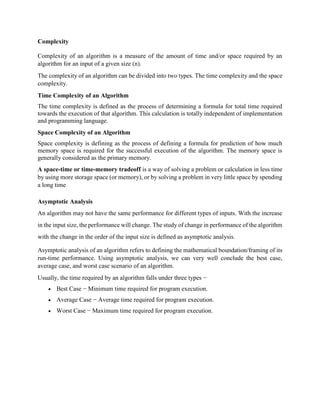
Complexity
- 1. Complexity Complexity of an algorithm is a measure of the amount of time and/or space required by an algorithm for an input of a given size (n). The complexity of an algorithm can be divided into two types. The time complexity and the space complexity. Time Complexity of an Algorithm The time complexity is defined as the process of determining a formula for total time required towards the execution of that algorithm. This calculation is totally independent of implementation and programming language. Space Complexity of an Algorithm Space complexity is defining as the process of defining a formula for prediction of how much memory space is required for the successful execution of the algorithm. The memory space is generally considered as the primary memory. A space-time or time-memory tradeoff is a way of solving a problem or calculation in less time by using more storage space (or memory), or by solving a problem in very little space by spending a long time Asymptotic Analysis An algorithm may not have the same performance for different types of inputs. With the increase in the input size, the performance will change. The study of change in performance of the algorithm with the change in the order of the input size is defined as asymptotic analysis. Asymptotic analysis of an algorithm refers to defining the mathematical boundation/framing of its run-time performance. Using asymptotic analysis, we can very well conclude the best case, average case, and worst case scenario of an algorithm. Usually, the time required by an algorithm falls under three types − Best Case − Minimum time required for program execution. Average Case − Average time required for program execution. Worst Case − Maximum time required for program execution.
- 2. Asymptotic Notations The efficiency of an algorithm depends on the amount of time, storage and other resources required to execute the algorithm. The efficiency is measured with the help of asymptotic notations. There are mainly three asymptotic notations: Big-O notation Omega notation Theta notation Big-O Notation (O-notation) Big-O notation represents the upper bound of the running time of an algorithm. Thus, it gives the worst-case complexity of an algorithm. O(g(n)) = { f(n): there exist positive constants c and n0 such that 0 ≤ f(n) ≤ cg(n) for all n ≥ n0 } The above expression can be described as a function f(n) belongs to the set O(g(n)) if there exists a positive constant c such that it lies between 0 and cg(n), for sufficiently large n. For any value of n, the running time of an algorithm does not cross the time provided by O(g(n)). Omega Notation (Ω-notation) Omega notation represents the lower bound of the running time of an algorithm. Thus, it provides the best case complexity of an algorithm. Ω(g(n)) = { f(n): there exist positive constants c and n0 such that 0 ≤ cg(n) ≤ f(n) for all n ≥ n0 } The above expression can be described as a function f(n) belongs to the set Ω(g(n)) if there exists a positive constant c such that it lies above cg(n), for sufficiently large n. For any value of n, the minimum time required by the algorithm is given by Omega Ω(g(n)). f(n)=2n+3 2n+3<= 10n n>=1 f(n)=O(n) f(n)=2n+3 2n+3>= 1n n>=1 f(n)=omega(n)
- 3. Theta Notation (Θ-notation) Theta notation encloses the function from above and below. Since it represents the upper and the lower bound of the running time of an algorithm, it is used for analyzing the average-case complexity of an algorithm. For a function g(n), Θ(g(n)) is given by the relation: Θ(g(n)) = { f(n): there exist positive constants c1, c2 and n0 such that 0 ≤ c1g(n) ≤ f(n) ≤ c2g(n) for all n ≥ n0 } The above expression can be described as a function f(n) belongs to the set Θ(g(n)) if there exist positive constants c1 and c2 such that it can be sandwiched between c1g(n) and c2g(n), for sufficiently large n. If a function f(n) lies anywhere in between c1g(n) and c2g(n) for all n ≥ n0, then f(n) is said to be asymptotically tight bound. f(n)=2n+3 1n<=2n+3<=5n n>=1 f(n)=theta(n)